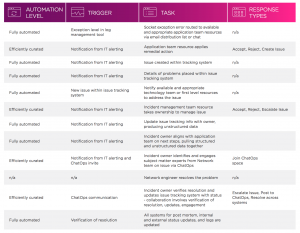Curate Manual Work, and Automate

You don’t have to rely all manual work or all automation. In fact, you should use a mix of automated and curated processes to make your IT organization more efficient while avoiding mistakes. Figuring out where to automate and where to curate manual work is one of the keys to efficient IT operations.
If you ask some of today’s business leaders, they’ll recommend automating every piece of manual work to make processes more efficient. Automation certainly plays a crucial role in business success, but it’s important for companies to differentiate between the tasks that computers can execute automatically and those that require a curated approach.
Instead of taking a fully-automated approach to manual work, you need to take a step back and review how your processes function, how well they help employees focus on work and how much they help customers succeed. You’ll likely discover that you need a mixture of automated and curated steps.
Defining a Fully Automated Process
You can’t deny that business process automation will play an increasingly key role in success. In 2016, the worldwide market for business process automation was worth $5.1 billion. Researchers expect the industry’s value to reach $12.7 billion by 2021.
More companies are investing in automation because it makes them more efficient and helps them save money. Fully automated processes do not need any assistance from employees. A completely automated company wouldn’t need any workers (other than IT professionals to maintain the hardware and software required for automation).
Don’t expect to find a fully automated company in the near future. Humans still play important roles at all levels of business.
Already, though, you can find areas of business where automation has taken over. You rarely need humans for tasks like:
- Backing up data
- Syndicating web content
- Generating invoices
- Tracking system logins
Software can do all of these jobs independently.
In fact, most humans would hate doing those boring, repetitive jobs. It makes much more sense to let bots handle simple tasks instead of forcing humans to waste their creativity on manual processes that don’t offer any challenges.
At times, though, you do need a human to step in and take control of a situation. Most websites use automated customer service bots that can answer basic questions. As long as the customer needs something very simple, the website can handle the request without help.
If the request becomes complicated, though, a human needs to get involved. There’s a big difference between telling a customer what time a store is open and helping a customer install a piece of software properly.
The Pros and Cons of Efficiently Curated Processes
Curated processes are primarily automated, but they rely on a human to determine what steps are taken. Not surprisingly, there are pros and cons to this approach, too.
In the customer service example above, an efficiently curated process might rely on a human employee to initiate the automated response. When a customer asks for a location’s business hours, the bot will answer. If this does not sufficiently answer the customer’s question, the employee can determine what steps to take next.
“Taking steps” doesn’t necessarily mean that the employee has to do meaningful work. It could mean telling the bot to send the customer a link to a website that describes location business hours. It could also mean redirecting the question to someone at the specific location.
The advantage of efficiently curated processes is that you give humans more control so they can ensure automated tasks avoid mistakes. The disadvantage is that you still have to pay the employee for performing mind-numbing, menial labor.
Finding the Right Mix of Automation and Curation for Your Organization
The good news is that you don’t have to rely on one type of system. Instead, you can use a mixture of automated and curated processes to make your organization more efficient while avoiding mistakes.
You can begin deciding how you want to perform tasks by looking at the triggers that initiate them. Some triggers almost always lead to tasks that software can handle without human intervention. Others, however, almost always need a person to make a judgment call or offer specialized knowledge.
Understanding the triggers and tasks will help you choose the automation level that works well for your organization.
For instance, if someone tries to login with the wrong password (that’s the trigger), then you can rely on a computer to generate a response and bar entry (that’s the task). In this example, the entire process is automated. No reasonable person would argue that a professional would need to write a response to an invalid login request.
Some situations can get a little more complicated, though. Let’s imagine a new scenario where the trigger is an alert notification from IT. Whether you choose to automate or curate the reaction depends on the task required. More than likely, you can fully automate tasks like logging problem details in a tracking system or updating a ticket’s progress. If solving the problem requires a remedial action from the IT team, though, efficiently curated responses could include choosing to accept, reject or create an issue ticket.
xMatters excels by giving you the option to change automated and curated tasks on the fly. On some occasions, you may want to automate a process fully. At other times, you may want to have an individual or group review tasks to make sure they are accomplished properly.
No matter how useful and affordable automation is, you can’t let it take over your tasks. Instead, you need a system that lets you identify how triggers get handled. When you have more control over your processes, you can make your automated and curated tasks more effective.


